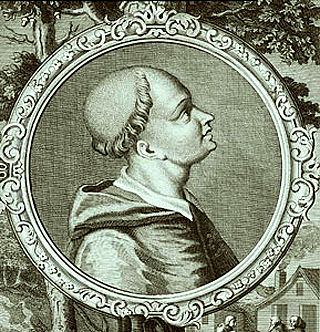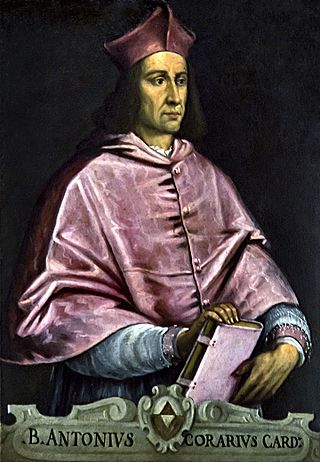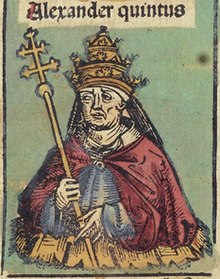An antipope is a person who claims to be Bishop of Rome and leader of the Catholic Church in opposition to the legitimately elected pope. Between the 3rd and mid-15th centuries, antipopes were supported by factions within the Church itself and secular rulers.

Baldassarre Cossa was Pisan antipope John XXIII (1410–1415) during the Western Schism. The Catholic Church regards him as an antipope, as he opposed Pope Gregory XII whom the Catholic Church now recognizes as the rightful successor of Saint Peter. He was also an opponent of Antipope Benedict XIII, who was recognized by the French clergy and monarchy as the legitimate Pontiff.
The Council of Constance was an ecumenical council of the Catholic Church that was held from 1414 to 1418 in the Bishopric of Constance (Konstanz) in present-day Germany. The council ended the Western Schism by deposing or accepting the resignation of the remaining papal claimants and by electing Pope Martin V. It was the last papal election to take place outside of Italy.

Pope Gregory XII, born Angelo Corraro, Corario, or Correr, was head of the Catholic Church from 30 November 1406 to 4 July 1415. Reigning during the Western Schism, he was opposed by the Avignon claimant Benedict XIII and the Pisan claimants Alexander V and John XXIII. Gregory XII wanted to unify the Church and voluntarily resigned in 1415 to end the schism.

The Western Schism, also known as the Papal Schism, the Great Occidental Schism, or the Schism of 1378, was a split within the Catholic Church lasting from 1378 to 1417 in which bishops residing in Rome and Avignon both claimed to be the true pope, and were joined by a third line of Pisan claimants in 1409. The schism was driven by personalities and political allegiances, with the Avignon papacy being closely associated with the French monarchy.

Pierre d'Ailly was a French theologian, astrologer and cardinal of the Roman Catholic Church.
In the history of Christianity and later of the Roman Catholic Church, there have been several Councils of Aquileia. The Roman city of Aquileia at the head of the Adriatic is the seat of an ancient episcopal see, seat of the Patriarch of Aquileia.

Pedro Martínez de Luna y Pérez de Gotor, known as el Papa Luna in Spanish and Pope Luna in English, was an Aragonese nobleman who, as Benedict XIII, is considered an antipope by the Catholic Church.

The Annuario Pontificio is the annual directory of the Holy See of the Catholic Church. It lists the popes in chronological order and all officials of the Holy See's departments. It also provides names and contact information for all cardinals and bishops, the dioceses, the departments of the Roman Curia, the Holy See's diplomatic missions abroad, the embassies accredited to the Holy See, the headquarters of religious institutes, certain academic institutions, and other similar information. The index includes, along with all the names in the body of the book, those of all priests who have been granted the title of "Monsignor".

Jean-Allarmet de Brogny was a French Cardinal.

The Tomb of Antipope John XXIII is the marble-and-bronze tomb monument of Antipope John XXIII, created by Donatello and Michelozzo for the Florence Baptistry adjacent to the Duomo. It was commissioned by the executors of Cossa's will after his death on December 22, 1419 and completed during the 1420s, establishing it as one of the early landmarks of Renaissance Florence. According to Ferdinand Gregorovius, the tomb is "at once the sepulchre of the Great Schism in the church and the last papal tomb which is outside Rome itself".

Antonio Correr was a Roman Catholic Cardinal who was appointed cardinal by his uncle Pope Gregory XII during the period of the Great Western Schism.

Rinaldo Brancaccio was an Italian cardinal from the 14th and 15th century, during the Western Schism. Other members of his family were also created cardinals: Landolfo Brancaccio (1294); Niccolò Brancaccio, pseudocardinal of Antipope Clement VII (1378); Ludovico Bonito (1408); Tommaso Brancaccio (1411); Francesco Maria Brancaccio (1633) and Stefano Brancaccio (1681). He was called the Cardinal Brancaccio.
The numbering of "Popes John" does not occur in strict numerical order. Although there have been twenty-one legitimate popes named John, the numbering has reached XXIII because of two clerical errors that were introduced in the Middle Ages: first, antipope John XVI was kept in the numbering sequence instead of being removed; then, the number XX was skipped because Pope John XXI counted John XIV twice.

Louis I of Bar was a French bishop of the 15th century and the de jure Duke of Bar from 1415 to 1430, ruling from the 1420s alongside his grand-nephew René of Anjou.
Domenec Ram y Lanaja was an aragonese politician and diplomat who was Viceroy of Sicily in 1415–1419, succeeding Prince John of Aragon, later King John II of Aragon.

Pope Innocent VII, the third Pope in the obedience of Rome during the Great Western Schism, created eleven new cardinals in one consistory celebrated on 12 June 1405:
- Corrado Caraccioli, archbishop of Mileto and camerlengo of the Holy Roman Church − cardinal-priest of S. Crisogono, † 15 February 1411
- Angelo Correr, Latin Patriarch of Constantinople, administrator of the see of Coron and governor of the March of Ancona − cardinal-priest of S. Marco, then Pope Gregory XII in the obedience of Rome ; became cardinal-bishop of Frascati (Tusculum) after his abdication, † 18 October 1417
- Francesco Uguccione, archbishop of Bordeaux − cardinal-priest of SS. IV Coronati, † 14 July 1412
- Giordano Orsini, archbishop of Naples − cardinal-priest of SS. Silvestro e Martino, then cardinal-bishop of Albano, cardinal-bishop of Sabiny, † 29 May 1438
- Giovanni Migliorati, archbishop of Ravenna − cardinal-priest of S. Croce in Gerusalemme, † 16 October 1410
- Pietro Filargo, OFM, archbishop of Milan − cardinal-priest of SS. XII Apostoli, then Antipope Alexander V in the obedience of Pisa, † 3 May 1410
- Antonio Arcioni, bishop of Ascoli Piceno − cardinal-priest of S. Pietro in Vincoli, † 21 July 1405
- Antonio Calvi, bishop of Todi − cardinal-priest of S. Prassede, then cardinal-priest of S. Marco, † 2 October 1411
- Oddone Colonna, administrator of the suburbicarian see of Palestrina − cardinal-deacon of S. Giorgio in Velabro, became Pope Martin V on 11 November 1417, † 20 February 1431
- Pietro Stefaneschi, protonotary apostolic − cardinal-deacon of S. Angelo in Pescheria, then cardinal-deacon of SS. Cosma e Damiano and again cardinal-deacon of S. Angelo in Pescheria (1410), † 30 October 1417
- Jean Gilles, papal legate in the ecclesiastical provinces of Cologne, Reims and Trier − cardinal-deacon of SS. Cosma e Damiano, † 1 July 1408

The Council of Pisa was a controversial council held in 1409. It attempted to end the Western Schism by deposing Benedict XIII (Avignon) and Gregory XII (Rome) for schism and manifest heresy. The College of Cardinals, composed of members of both the Avignon Obedience and the Roman Obedience, who were recognized by each other and by the Council, then elected a third papal claimant, Alexander V, who lived only a few months. He was succeeded by John XXIII.

Niccolò Brancaccio was born in the Kingdom of Naples, perhaps in Naples itself. He was Archbishop of Bari and then Archbishop of Cosenza, while serving in the Roman Curia in Avignon. He became a cardinal of the Avignon Obedience in 1378, and was Cardinal Priest of Santa Maria in Trastevere and then Cardinal Bishop of Albano. He participated in the Council of Pisa in 1409, and was one of the electors of Pope Alexander V and of Pope John XXIII.















